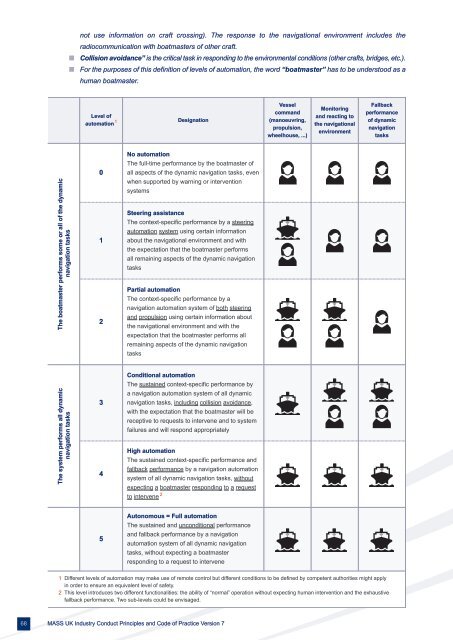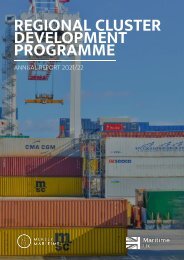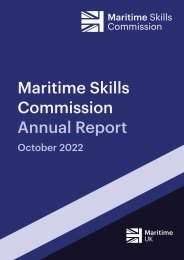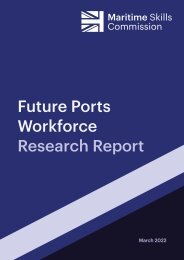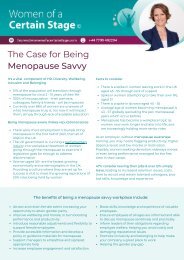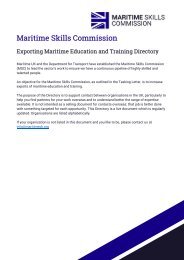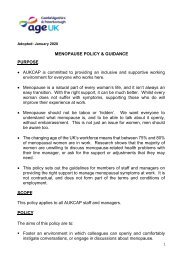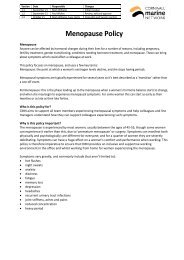COP_2023_V7_pages
Create successful ePaper yourself
Turn your PDF publications into a flip-book with our unique Google optimized e-Paper software.
n not use information on craft crossing). The response to the navigational environment includes the<br />
radiocommunication with boatmasters of other craft.<br />
n Collision avoidance” is the critical task in responding to the environmental conditions (other crafts, bridges, etc.).<br />
n For the purposes of this definition of levels of automation, the word “boatmaster” has to be understood as a<br />
human boatmaster.<br />
Level of<br />
automation 1<br />
Designation<br />
Vessel<br />
command<br />
(manoeuvring,<br />
propulsion,<br />
wheelhouse, ...)<br />
Monitoring<br />
and reacting to<br />
the navigational<br />
environment<br />
Fallback<br />
performance<br />
of dynamic<br />
navigation<br />
tasks<br />
The boatmaster performs some or all of the dynamic<br />
navigation tasks<br />
0<br />
1<br />
2<br />
No automation<br />
The full-time performance by the boatmaster of<br />
all aspects of the dynamic navigation tasks, even<br />
when supported by warning or intervention<br />
systems<br />
Steering assistance<br />
The context-specific performance by a steering<br />
automation system using certain information<br />
about the navigational environment and with<br />
the expectation that the boatmaster performs<br />
all remaining aspects of the dynamic navigation<br />
tasks<br />
Partial automation<br />
The context-specific performance by a<br />
navigation automation system of both steering<br />
and propulsion using certain information about<br />
the navigational environment and with the<br />
expectation that the boatmaster performs all<br />
remaining aspects of the dynamic navigation<br />
tasks<br />
The system performs all dynamic<br />
navigation tasks<br />
3<br />
4<br />
Conditional automation<br />
The sustained context-specific performance by<br />
a navigation automation system of all dynamic<br />
navigation tasks, including collision avoidance,<br />
with the expectation that the boatmaster will be<br />
receptive to requests to intervene and to system<br />
failures and will respond appropriately<br />
High automation<br />
The sustained context-specific performance and<br />
fallback performance by a navigation automation<br />
system of all dynamic navigation tasks, without<br />
expecting a boatmaster responding to a request<br />
to intervene 2<br />
5<br />
Autonomous = Full automation<br />
The sustained and unconditional performance<br />
and fallback performance by a navigation<br />
automation system of all dynamic navigation<br />
tasks, without expecting a boatmaster<br />
responding to a request to intervene<br />
1 Different levels of automation may make use of remote control but different conditions to be defined by competent authorities might apply<br />
in order to ensure an equivalent level of safety.<br />
2 This level introduces two different functionalities: the ability of “normal” operation without expecting human intervention and the exhaustive<br />
fallback performance. Two sub-levels could be envisaged.<br />
68<br />
MASS UK Industry Conduct Principles and Code of Practice Version 7


